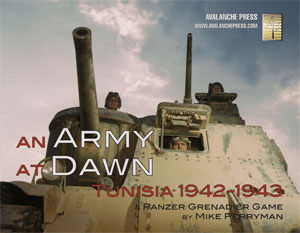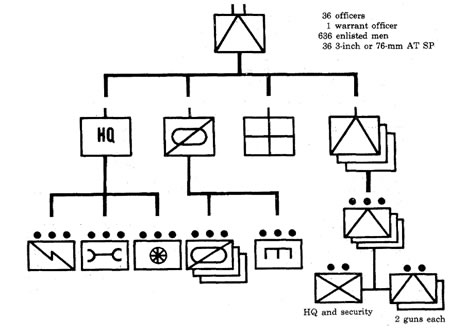| Tank Destroyer Command:
Part Three, Better Weapons
By Peter Lloyd
May 2019
 Long before the tank panic of 1940, the U.S Army had started experimenting with a motor mount for the new M6 37mm antitank gun. The mount chosen was the 6x6 three-quarter-ton truck. The experimental vehicle was designated T21. Development was suspended when Tank Destroyer Command was formed, because the command was interested in heavier weapons. The project was revived as difficulties with the M5 accumulated and the need for training vehicles rose. The M6 Gun Motor Carriage was the standardized model. The M6 was never intended for combat. However, when the time came to sail for North Africa, Tank Destroyer Command was only just starting to receive M10 deliveries, so the M6 went to war. When the M6 went overseas it was fitted with small arms holsters (like the "Rat Patrol" jeeps) for close defense weapons, but there wasn’t much else that could be done for it. Long before the tank panic of 1940, the U.S Army had started experimenting with a motor mount for the new M6 37mm antitank gun. The mount chosen was the 6x6 three-quarter-ton truck. The experimental vehicle was designated T21. Development was suspended when Tank Destroyer Command was formed, because the command was interested in heavier weapons. The project was revived as difficulties with the M5 accumulated and the need for training vehicles rose. The M6 Gun Motor Carriage was the standardized model. The M6 was never intended for combat. However, when the time came to sail for North Africa, Tank Destroyer Command was only just starting to receive M10 deliveries, so the M6 went to war. When the M6 went overseas it was fitted with small arms holsters (like the "Rat Patrol" jeeps) for close defense weapons, but there wasn’t much else that could be done for it.
 Development of a purpose-built tank destroyer was going to take a while. The T35 project was initiated to fill the gap. Begun November 1941, the T35 was to lead to the first true tank destroyer for the U.S. Army. It began with the M4A2 hull, which was mated with the M6 heavy tank turret. The resulting vehicle silhouette was too high for Tank Destroyer Command’s liking. The turret was reworked by removing the roof and cutting down the sides. This variation was designated T35E1. An antiaircraft machine-gun was added, and the armor on the turret sides was reduced and angled. The final design was standardized as the M10 Gun Motor Carriage in June 1942. The first units began coming off the assembly line in September. Deliveries to combat units began in November, just a little too late for participation in Operation Torch. Development of a purpose-built tank destroyer was going to take a while. The T35 project was initiated to fill the gap. Begun November 1941, the T35 was to lead to the first true tank destroyer for the U.S. Army. It began with the M4A2 hull, which was mated with the M6 heavy tank turret. The resulting vehicle silhouette was too high for Tank Destroyer Command’s liking. The turret was reworked by removing the roof and cutting down the sides. This variation was designated T35E1. An antiaircraft machine-gun was added, and the armor on the turret sides was reduced and angled. The final design was standardized as the M10 Gun Motor Carriage in June 1942. The first units began coming off the assembly line in September. Deliveries to combat units began in November, just a little too late for participation in Operation Torch.
 With the M3, M6, and M10 Gun Motor Carriages, Tank Destroyer Command went to challenge the panzer hordes. In the North Africa campaign, tank destroyer battalions came in two flavors. First there was the hybrid version which is what the diagram reflects. The other was the “heavy” battalion, entirely equipped with M10 GMC’s as the antitank weaponry. Both of these formations had flaws in their equipment and organization. Tank destroyer battalions were overly large and logistically cumbersome, especially in regard to the hybrid units. March 1943 brought a reorganization. The hybrid battalions were converted to heavy battalions, with the M10 being the designated tank destroyer to be used. The antiaircraft sections, along with their logistical requirement, were eliminated. These changes reduced the manpower requirement by almost 200 men per battalion and somewhat improved the support situation. With the M3, M6, and M10 Gun Motor Carriages, Tank Destroyer Command went to challenge the panzer hordes. In the North Africa campaign, tank destroyer battalions came in two flavors. First there was the hybrid version which is what the diagram reflects. The other was the “heavy” battalion, entirely equipped with M10 GMC’s as the antitank weaponry. Both of these formations had flaws in their equipment and organization. Tank destroyer battalions were overly large and logistically cumbersome, especially in regard to the hybrid units. March 1943 brought a reorganization. The hybrid battalions were converted to heavy battalions, with the M10 being the designated tank destroyer to be used. The antiaircraft sections, along with their logistical requirement, were eliminated. These changes reduced the manpower requirement by almost 200 men per battalion and somewhat improved the support situation.

The 1943, reorganized, self-propelled tank destroyer battalion
Not everyone was, or ever had been, happy with Tank Destroyer Command. General Omar Bradley was particularly opposed to the infantry’s loss of its organic antitank battalions. At his urging, the towed tank destroyer battalion came into existence in May of 1943. The basic weapon to be used was the 3-inch M5 antitank gun which had been used in the M10. The guns were to be towed using halftracks to maintain some off-road mobility. Apart from a reduced reconnaissance element, under the headquarters company, the towed battalion looked much like its self-propelled counterpart. The personnel requirement rose back to nearly what that of the original tank destroyer battalion had been.

Towed tank destroyer battalion, 1943
 Regardless of what General Bradley wanted, the self-propelled gun was still the centerpiece of tank destroyer doctrine. What the Tank Destroyer Command had wanted since its creation was a low-profile vehicle, with a powerful gun, that was fast. The M10 was too slow and Tank Destroyer Command did not like expediencies that had produced it. The first purpose-built tank destroyer project was the T49, but at 57mm, the gun was too small. The T67 design showed promise, using the same gun as in the M10. That design was dropped as the 76mm/L56 gun became a real possibility and development moved to the T70 project. The T70 was built on a modified Christie suspension, which made it fast, very fast. It had the long 3-inch gun. The standardized version of the T70 was the M18 Gun Motor Carriage. This was finally the weapon which Generals McNair and Bruce had been longing for. In mid-1943 the first units were coming off the assembly line. Regardless of what General Bradley wanted, the self-propelled gun was still the centerpiece of tank destroyer doctrine. What the Tank Destroyer Command had wanted since its creation was a low-profile vehicle, with a powerful gun, that was fast. The M10 was too slow and Tank Destroyer Command did not like expediencies that had produced it. The first purpose-built tank destroyer project was the T49, but at 57mm, the gun was too small. The T67 design showed promise, using the same gun as in the M10. That design was dropped as the 76mm/L56 gun became a real possibility and development moved to the T70 project. The T70 was built on a modified Christie suspension, which made it fast, very fast. It had the long 3-inch gun. The standardized version of the T70 was the M18 Gun Motor Carriage. This was finally the weapon which Generals McNair and Bruce had been longing for. In mid-1943 the first units were coming off the assembly line.
 Just about when the first M10’s were being built, the Ordinance Department, largely against the wishes of Tank Destroyer Command, was looking for something bigger. Close on the heels of the T70 development came the T71. The project was to mount an antitank version of the 90mm antiaircraft gun. To do this the design board turned again to the M4 chassis. The turret ring was adequate to support mounting the 90mm gun, but the mass of the weapon required a large counterweight to be added to the turret’s rear. The result was standardized as the M36 Gun Motor Carriage in June of 1944. The first M36 Jacksons went into action against the Germans in September 1944. Just about when the first M10’s were being built, the Ordinance Department, largely against the wishes of Tank Destroyer Command, was looking for something bigger. Close on the heels of the T70 development came the T71. The project was to mount an antitank version of the 90mm antiaircraft gun. To do this the design board turned again to the M4 chassis. The turret ring was adequate to support mounting the 90mm gun, but the mass of the weapon required a large counterweight to be added to the turret’s rear. The result was standardized as the M36 Gun Motor Carriage in June of 1944. The first M36 Jacksons went into action against the Germans in September 1944.
These are the tools of Tank Destroyer Command’s trade. Now that why they are here, and what they will use has been established. The next step, and portion of this series, will be to examine their performance.
Send your tank destroyers into battle! Order An Army at Dawn right now!
Sign up for our newsletter right here. Your info will never be sold or transferred; we'll just use it to update you on new games and new offers.
|
